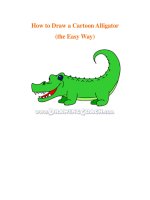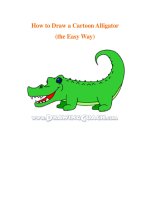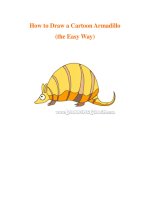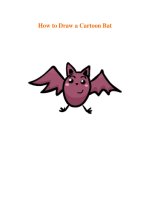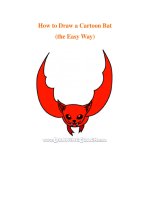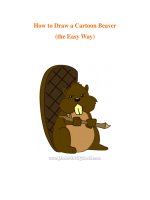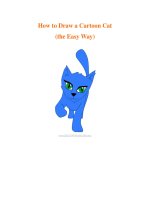Cartoon Cool: How to Draw New Retro-Style Characters
Bạn đang xem bản rút gọn của tài liệu. Xem và tải ngay bản đầy đủ của tài liệu tại đây (13.4 MB, 116 trang )
How to Draw
New Retro-Style
Characters
Christopher hart
Watson-Guptill Publications New York
/
Published in 2005 by Watson-Guptill Publications
a division of VNU Business Media, Inc.
770 Broadway
New York, NY 10003
www.wgpub.com
Executive Editor: Candace Raney
Senior Development Editor: Alisa Palazzo
Designer: Bob Fillie, Graphiti Design. Inc
Senior Production Manager: Ellen Greene
Inks over pencil: Rich Faber
(pages 99. 103, 105, 106, 107. 109, and 110)
Copyright © 2005 Art Studio, LLC
Library of Congress Cataloging-in-Publication Data
Hart, Christopher.
Cartoon cool; how to draw the new retro characters
of today’s cartoons / Christopher Hart.
p. cm.
Includes bibliographical references and index.
ISBN 0-8230-0587-9 (pbk. : alk. paper)
1. Cartooning Technique, I. Title.
NC1764.H34 2005
741.5 dc22
2004024844
All rights reserved. No part of the contents of this
publication may be reproduced or used in any form
or by any means graphic, electronic, or mechanical.
including photocopying, recording, or information
storage-and-retrieval systems without the written
permission of the publisher.
Printed In USA
23456789/131211100908070605
THE SUBURBAN DAD
HOME ON THE RANGE: THE BARBECUE
A DAD, A BATHROBE, AND A CUP OF COFFEE
DADS WITH GLASSES
MORE DAD SHAPES
THE PERSISTENCE OF DAD
THE BASIC RETRO MOM
MOM HEAD PROPORTIONS
DANGER—MOM ATTEMPTING TO BE COOL
PERKY MOM
SHOP AROUND THE CLOCK
WALK-ABOUT MOM
THE SADISTIC OLDER SISTER
YOU ARE SO DEAD!
DOLLS AND PAJAMAS
THE BRINGER OF BAD CHEER
THE KNOW-IT-ALL SISTER
EVIL AT HOME, EVIL IN CLASS
THE YOUNGER BROTHER
MORE BOYS
RETRO KIDS AND SPORTS
Introduction: Lets Go Retro!
Retro Basics
The Retro Family
Cool Retro Action Poses
The Retro Family Pet
Cool Retro Teenagers
Pretty Retro Women
Cool Retro Scenes
Index
4
58
9
60
6
59
6
56
57
11
62
10
61
12
63
15
64
14
64
29
72
30
74
32
83
82
81
80
79
78
77
76
76
18
65
33
84
34
86
49
102
50
104
51
106
52
107
53
108
54
111
55
112
43
95
47
98
45
97
48
100
46
98
35
87
42
93
36
88
37
89
38
90
39
90
40
92
41
94
22
66
26
70
24
71
27
73
28
75
44
96
23
69
THE RETRO HEAD
MORE HEAD SHAPES
ENLARGING THE UPPER JAW
DRAWING “FLAT” CHARACTERS
EYES
LIPS
FACIAL EXPRESSIONS
RETRO BODIES
PROPORTIONS
BODY SIZE
THE IDEALIZED CARTOON FIGURE: TRADITIONAL VS. RETRO
THE NECK AND SHOULDERS
BUILDING THE BODY SECTION BY SECTION
“MOLDING” THE TORSO
THE FEMALE TORSO
THE ATTRACTIVE FEMALE FIGURE STEP BY STEP
RETRO HANDS
FEET
TRADITIONAL VS. RETRO ACTION POSES
INTROVERTED POSES
THE MEGAPUNCH
FLYING
THE RETRO “TAKE”
MORE ACTION POSES
THE EPIPHANY
THE CARTOON DOG
PUPPY DOG EYES
COMMON HOUSEHOLD DOG BREEDS
MUTTS
CATS AS PETS
BASIC CAT HEAD SHAPES
THE SIAMESE CAT
SURLY CAT
BIRDS AS PETS: POPULAR TYPES
TROPICAL FISH AND AQUARIUM PETS
SERIOUS TEENAGE BOY
CAREFREE TEEN
PRETTY TEEN
STYLISH TEEN
COOL CAT
HANGIN’ AT THE MALL
LOOSEY-GOOSEY TEEN
THE GIRL NEXT DOOR
SCHOOL SCENE
THE REBEL
POSTURE
BASIC TEENAGE STANDING POSTURE
POSE AND EMOTION
THE FACE
THE VOLUPTUOUS FEMALE FIGURE
MIDRIFFS AND LOW-CUT PANTS
COOL CHICK
CAN’T BUY ME LOVE
NOTES ON DRAWING ATTRACTIVE POSES
PRIMITIVE BEAUTY
NO, YOU GO FIRST
SECRET AGENT CHICK
GALACTIC MEDAL OF VALOR
SHH! SECRET MISSION
JEWEL THIEF
MY HERO!
HERE MONSTER, MONSTER
BYE FOR NOW: A CLOSING NOTE FROM CHRIS HART
t's everywhere you look, in animated
television shows and comic books. It's
the new retro style. What is retro? It's the
biggest thing to come along in cartooning
in decades. It's a style of illustration
loosely based on the animated TV shows of
the late 1950s and early 1960s—a time when
everything had a flat, graphic look, and the
sly humor didn't play down to children.
Retro is also based on character types
character types influenced by the popular
family sitcoms of the early to mid-'60s, when
everything looked nice on the surface: brownies
and milk, moms in the kitchen, and fathers who
never yelled. Yet there was always lurking a
sense that these families were too good to be
true and were repressing some truly bizarre
personalities and behaviors. Add a modern
look, bring those bizarre personalities to the
surface, ratchet up the pace to a fever pitch,
and you've got retro. As a cartoonist, you owe
it to yourself to stay current and learn how to
draw this growing, popular new style.
Interestingly, some of the retro-style
drawing principles are the exact opposite
of the principles used for drawing traditional
cartoons. For example, retro-style action poses
are drawn so that the figures seem to conserve
energy rather than expend it (which would be
the look of a more traditional cartoon).
Retro characters are so nerdy they're cool.
The retro style is, in fact, the coolest style of
cartooning on the planet. Retro-style animated
TV shows have completely stolen the thunder
of hand-drawn, animated feature films. While
the popularity of the hand-drawn, realistic style
of animated movies has waned, retro cartoons
are proliferating all over television. And even
the most heroic comic book characters and bad
guys have been redrawn by publishers and
studios into modern, retro versions. But retro
is about more than just style; it's also about
laughs. It's truly wacky stuff. The characters are
quirky, perky, and just a little bit warped. Their
break-neck pacing and hysterical characters are
generating legions of fans of all ages.
This book is packed to the brim with easy-to-
follow, step-by-step instructions and loads of
special hints. Anyone, at any level, can benefit
and can improve his or her skills by using this
book. You'll be shown how to create retro-style
heads and bodies from basic shapes, making it
easy and fun. You'll learn how to create the
basic cast of characters that make up the
bizarre retro family unit, including retro pets.
You'll learn how to caricature action poses in
the unique, retro style, with examples that
compare the new way to the traditional way of
cartooning. Retro facial expressions and body
language are illustrated clearly and in detail.
And at the end of the book, you'll be guided
through an exciting section on how to draw
scenes with multiple characters. Are you ready?
Let's go retro!
I
Simple shapes are the key to creating
today's "new retro" look, and there's
no shape simpler than a circle. It's
perfectly symmetrical and has no
sides. But pay close attention—I'm
definitely not talking about the old-
fashioned, start-with-a-circle approach
to cartooning. I'm talking about a self-
consciously round cartoon, in which
the shape of the circle is not just the
starting point but the whole point. To
emphasize the circle further in the
front view, don't open up the circle
at the chin as it crosses the neck;
keep it a closed loop.
Tilt the eyes, in tandem, to one side. This
is a cartoonist's trick that adds more zing
to the character. Big irises (the colored
parts of the eyes) are the favored look
in Retroland. The nose is tiny and petite,
letting the oversized eyes dominate by
way of contrast. And, the lips are full
and curvy—a caricature of female lips.
The hairstyle should never be carefree
or natural looking in retro cartoons.
Instead, it should look stiff, not soft.
Draw a thin neck that's so
skinny it would never really
support the weight of that
head. Exaggeration is the
key to cartoon humor.
Now draw small, dark pupils inside
the irises. The eyelashes should look
like little spikes that could kill
(which makes them funny). And you
can add striations to the interior of
the hairstyle, to give it more flair.
believe in drawing the fun stuff
right out of the box. So, we're going
to begin with the basic retro head.
As you go along, there'll be lots of special
hints throughout the book to help you
understand the principles of character
design and to provide you with options
for creating variations on a theme.
7
Indent the
forehead
lip detail
The oval is also a popular shape for retro
characters. Notice that the oval shape is
the dominant feature of this figure.
The eye is quite
oversized, which is
a popular trait in
retro-style cartoons.
Notice how big the hair is—
another retro trademark. Also,
you can't keep the outline of the
oval completely closed in the side
view because there's no chin to
obscure the neck. So, open it up
where it attaches to the neck.
Start with the oval
tilted on its axis.
The tilt gives the
pose more energy.
8
Now let's modify the basic shape a bit more so
that it's somewhere between an egg shape and an
upside-down teardrop shape. This is a common
shape for teenagers of about 14 years of age. The
face is still round but shows signs of elongation,
especially in the jaw and chin. Yet the face is
somewhat soft, as shown by its rounded sides.
Here's another character
with a crystal-clear shape
for her head. Not even her
chin, cheek, or hairline
creates so much as a bump
in the outline of the head,
which is a simple oval. It's
a very pleasing look. The
eye is drawn to simple
shapes.
Keep the features simple,
big, and clear, with no
subtlety. Eliminate all
facial creases—you don't
need them, and they take
away from the clean look
of the character. The ears
stick out conspicuously on
retro characters so that
they're funny looking!
(Only one ear shows in
this angle, though.)
Start with the basic shape.
Note that boys' necks get
thicker as they grow.
Sketch in guidelines.
Add the hair,
and thicken
the eyebrows.
Retro cartoons are based more on design
principles and less on drawing principles.
It's like fitting together cool parts to create
a snappy character. Sometimes artists try
to do too much with their drawings. bo less,
not more. Concentrate on the overall shapes,
not on the interior features.
9
Any basic shape can be turned into a retro-
type cartoon character. Give these three a try.
The back of
his head is a
continuation
of the jawline.
The ears droop on sullen
and glum characters.
Jazz up basic head
shapes on female
characters with
creative ponytails.
To make your character stand out more, try this effective
technique: enlarge the top of the mouth or upper jaw (the maxilla),
and leave the lower jaw (the mandible) unchanged. This will
immediately add a goofy look to any character.
Top extends
Bottom remains
the same
Bottom
remains
the same
Top extends
10
The key to drawing retro characters is to
make them look flat. This probably goes against
everything you've learned about how to draw,
when the whole point is to make things look
real and three-dimensional. But the flat look is
indispensable for drawing this new retro style.
Here are some important tips to keep in mind.
A bold, simple, and clear outline
is all-important in creating a flat
look. To create a flat character, the
outline of the head and body should be
emphasized so that the overall shape
is unmistakable. Make the outline thick
and make the lines for the details inside
the main outline thin. That's the general
rule, although you can break it
when, for example, one part of
the body overlaps another.
Start by drawing the
entire character in
a regular, thin line.
Don't thicken the
outline as you go!
Then, choose only
one side of the line
on which to add
width. If you add
width to both sides
of the line at the
same time, you end
up with a mishmash.
thin line
Ears
stick out
Tummy sticks
out in a
cute way
Main pencil line
is quite thick
Lower lip
shows thickness
Cheek
protrudes
Forehead
curves in
Shoulders
slope
amiably
Eyebrows
are thick and
are visible
through hair
as if sitting
on top of it
Hair has
striations in it
Back is
straight
for s stiff
and flat look
Front of head
is a single,
unchanging curve
right
wrong
(
(
)
)
11
Since the eyes are the most expressive feature
of the face, matching the correct eye style to the
character type is essential. Whenever I begin to
draw the features of the face, I start with the eyes.
If they don't come out just right, I erase them
and start over. I just can't get the feeling of the
character, and go on to create the expression and
posture, unless the eyes are working for me first.
There's no wasted effort in drawing eyes! (And
certainly no waste in designing and drawing them
first.) All of your efforts will pay dividends.
Style, and lots of it, is the name of the game in
drawing retro cartoons. And that's especially
important for female eyes.
This is a classic. Circular eyes with attached eyelashes
and large pupils. Very popular, very funny, especially
for cartoon moms.
Here's another favorite for cartoon moms that can also be
used effectively for perky teenage girls. The eyelashes curve
upward. The eyes are vertical elongated ovals. Note the use
of a two-toned iris and pupil area here.
This eye type can be used on an attractive character,
a mysterious character, or a sinister character equally
well. The eyelids are shaded to indicate eye shadow. The
eyeballs have pupils, and the eyelashes curve down.
(Note the thick eyebrows.)
Another appealing, goofy look. The eyes press together,
the pupils are small, and the eyelashes "float." (See page
74 for more on floating.)
Pretty severe, eh? She's evil, you betcha. Apply that eyeliner
like shellac.
These are for attractive female characters only. The half-
closed eyelids always indicate an alluring character. The top
eyelid is always drawn darker. The eyelashes are bunched
into a single, thick lash that sweeps up at the end.
These kooky eyes are shaped like rounded rectangles. For
an even more stylized look, place the pupils in the center
of the eyeballs, instead of close together. It will give
your character a weird, vacant stare.
She's the girl next door. Innocent characters have big
eyes with big shines in them. The overall form of the eye
is almond-shaped. To make her sexier, tilt the eyes up
slightly at the ends.
12
13
For male characters, too, there's a wide variety of eye
types from which to choose. Although male characters
don't have eyelashes with which to play, their eyebrows
are far more varied than those on female characters.
This is the classic retro look, good for almost any male
character: round eyes, with medium-size pupils (and no irises).
An appealing, quirky look. The eyes are oval and spaced apart,
with small pupils floating in the middle and thin eyebrows.
The eyes stand up, vertically, with small pupils. Good for
worried and high-energy grown-ups.
Isn't this one a riot? He's either a mad professor or an evil
scientist. Heavy eyelids and bags under the eyes, with only
slits for him to see through. Tiny beady eyes peer out at us.
The eyebrows are thin, crooked, and delicate.
Intense and mean characters (drill sergeants, phys-ed
coaches, and the like) often sport heavy eyebrows that
sit right on top of the pupils. Add a little touch of
shading under the eyes to add intensity.
A good type for boys ages 8 to 12. Huge pupils dominate
the eyes. The eyebrows are small.
This is the overworked dad type. Note how the eyelids
slope down at the ends. Bags form under the eyes, and
the eyebrows are thick and angular. This is how you
will look at 40. Trust me.
Almond-shaped eyes always indicate innocence and lack
of guile on boys. The pupils must be large, which is also
a sign of honesty in a character.
14
Here's where a lot of beginners—as well as
experienced cartoonists—lose their way and end up
with less attractive characters than they had hoped
for. Men's lips are so simple that they don't even
require separate examples here. You'll learn to draw
them easily just by following the steps for the male
characters in this book. It's women's lips that you
need to pay special attention to.
Actually, attractive, women's lips are some of
the easier things to draw—if you know which type
of lips you're drawing. The problem is that many
cartoonists don't decide on the lip type and end up
with an uncomfortable amalgam of realistic lips
and cartoony lips. Toss out the realistic version.
Instead, make them highly stylized, which simplifies
them and makes them much more fun.
Upper lip slants
inward in profile
Tip of top lip
overlaps
bottom lip
in profile
This is the classic overbite. It's attractive, some would even
say sexy, for the upper lip to be longer than the bottom one.
The indentation in the center of the upper lip, resulting in a
Cupid's bow shape, is simple and doesn't require any subtlety;
it can be used to make a character more voluptuous.
This is a good type for pouty cartoon characters. Both
the upper and bottom lips are of even length, but they're
short widthwise and tall heightwise.
Here's the overbite without the Cupid's bow shape. Generally
speaking, the more attractive the character, the bigger
the upper lip.
The dipping lip is usually used for attractive female
characters. It's the same as the first lip style, except that
the middle of the upper lip dips down and the bottom lip
widens slightly to accommodate this.
These are the simplest lips you con draw. They work well,
and they're funny. No Cupid's bow shape, not much of an
overbite. Give it a try.
The big bottom lip isn't that commonly used but can be
effective in creating a unique character.
15
Upset eye
variation
The solid shape of the face—its outline—is so
important on retro cartoon characters that it doesn't
squash or stretch to fit a particular expression the
way it would in a traditionally drawn cartoon. Most
of the action occurs in the eyes and the elastic
mouth. Here's a sampling of the most popular
expressions you'll need to know. Note how the
basic outline or shape of the head remains
unchanged from expression to expression.
The eyeballs must
be cut off by the
eyebrows. The mouth
is small and taut.
One eyebrow goes up, the
other down, and both eyes
are half closed. This is a
much more sophisticated
expression than one would
expect to find on a boy of
this character's age. But
that's what makes it funny.
Teeth usually show when
a character is angry.
Bright eyes, tongue
firmly pasted on
upper lip. Yum!
The tongue in the
middle of the mouth
indicates that the
character is talking
16
I love this one. Showing the
lower eyelids in an expression was
very popular in 1930s cartoons but
went by the wayside until recently.
Now this technique is used all over
the place. Note that the grin must
rise way up into the cheeks.
Closed eyes show confidence.
Combine them with a big grin
and you've got a know-it-all.
A surprised expression is
displayed by showing large,
round eyes with tiny pupils.
The pupils can actually change
size to fit the expression.
Note the body
language. Instead of
eyebrows, use big
folds of eyebrow
muscles to curl up
over the eyes. The
mouth gets small.
Scrunch all of the
features together in the
middle of the face. The
eyes crush down and
the mouth pushes up.
CONCERNED
MOUTH
VARIATION
BIGGER SURPRISED LOOK
17
Sympathy is an important emotion
to give characters. It humanizes
them. Combine a smile with worried
eyes for a look of sympathy.
All young characters need
to have this look in their
repertoire of expressions.
God knows I looked like this
enough when I was growing
up! Tilt the head down. The
pose won't be effective unless
the head is bowed. The
character needs to be looking
up from the corner of the eyes.
Keep the mouth tiny. This
expression is often followed
by the Sheepish one on
the previous page.
Combine a scrunched
smile with evil eyes for
an effective look.
Take the eyes from the Superior
expression on the previous page,
flip 'em over, and you've got the
eyes for a laughing character.
The mouth opens wide, but you
don't necessarily have to show
teeth or a tongue.
The affable smile is
just a big grin with the
eyebrows raised high.
It helps if you can
position the pupils in
a corner of the eyes,
as this makes the
expression sharper.
Even on a breezy,
pleasant expression
like this, it's good to
exaggerate something,
which in this case is
the curl of the grin.
18
Ponytails float
for added style
Just like the head shape, the retro
body—especially the torso—must
be based on a simple and clear
shape. Don't soften the edges
to make it subtler. That's a fine
approach for traditional cartoons,
but it won't give you that retro look.
Young characters have
heads that are large
compared to their bodies.
This doesn't usually hold
true for adult characters,
but in retro-style cartoons,
the head is usually big
even on adults. Still, let's
start with kids anyway,
because they're compact
and easier to draw.
19
Since we're concentrating
on creating a single, basic
shape for the body, the
outline of the dress itself
will become the shape
of the body. In retro
cartoons, you don't want
to see the stress marks
that result from the body
tugging on the fabric. There are
no creases or folds to complicate
the drawing, which must remain
simple and slick in order to
be pleasing to the eye.
Note the absolutely flat tops
of the ponytails. This could never
happen in reality, but again, we're
trying to emphasize shapes.
There are only two ways to do
this: either flatten things out or
make them round. Combining flat
shapes (the tops of the ponytails)
with round shapes (the top of her
head) adds a lively contrast.
20
The lab coat is a classic for evil characters. Note the
excessively long body, combined with a big head. This
tells the audience that the character relies on brainpower,
not brawn. The bow tie, which is tight enough to strangle
this guy, indicates that he's tightly wound and barely able
to maintain a socially acceptable demeanor in public.
In traditional cartooning, you'd first outline the body,
sketching in the legs as they wedge into the hip joints,
and then you'd draw the lab coat over it. But that would
be a mistake here. Here, the legs are meant to look pasted
onto the bottom of the coat. The fact that
there isn't a single hint or indication of the
underlying body structure is what gives
this cartoon its sought-after flat look.
21
Sweater to
combat poor
circulation
Skinny
upper arms
Bushy eyebrows
Perpetually
bent knees
Flat feet
The older a cartoon character gets, the
simpler the body shape becomes. The
neck disappears, and so do the shoulders.
The knees are perpetually bent. The limbs
are skinny, and the body is thick.
When you're trying to depict an
attractive character's body, you
have to draw a slightly more
complex shape for the torso.
It's sort of a mangled figure
eight, but you can still simplify
it so that it has a clear outline.
You can squash, bend,
flatten, and stretch
the torso shape any
way you like.
22
The common method of coming up with the proportions of
a character is to "stack heads." The standard approach has
always been: the younger the character, the fewer heads tall;
the more mature the character, the more heads tall. But with
retro cartoons, this isn't necessarily so. This retro-style
Kewpie-cloll bombshell is only three heads tall, whereas most
traditional adult cartoon characters are four to six heads tall.
The body is a third
of the width of the
head. This is what
gives this figure her
diminutive, cute look.
1/3
1/3
1/3
23
Super slender or on the wide side? Or, how
about splitting the difference and choosing
a body type down the middle? Today's
cartoon characters are so pliable that you
can give them body types that would have
previously been considered too thin.
The superthin
body type is a
good choice
for the retro
look, especially
for brainy kids.
In the retro style,
the average body
type is still thin but
not will-o'-the-wisp.
The larger look is yet another
variation; it makes clothes look
like they're swimming on the body,
which is a good look for kids.



